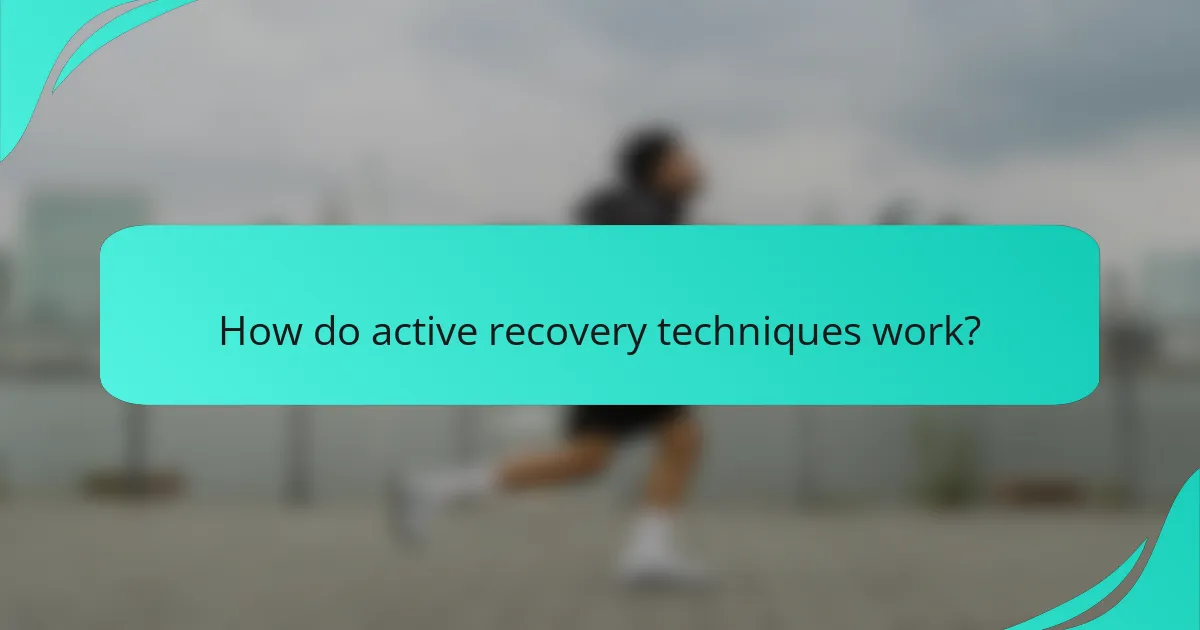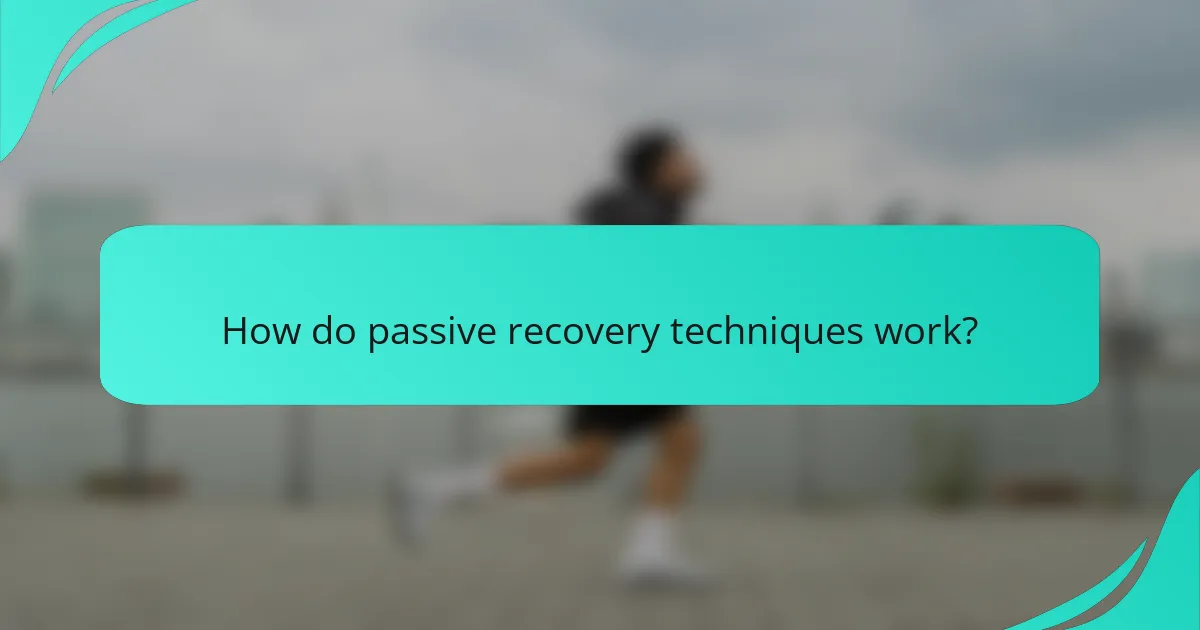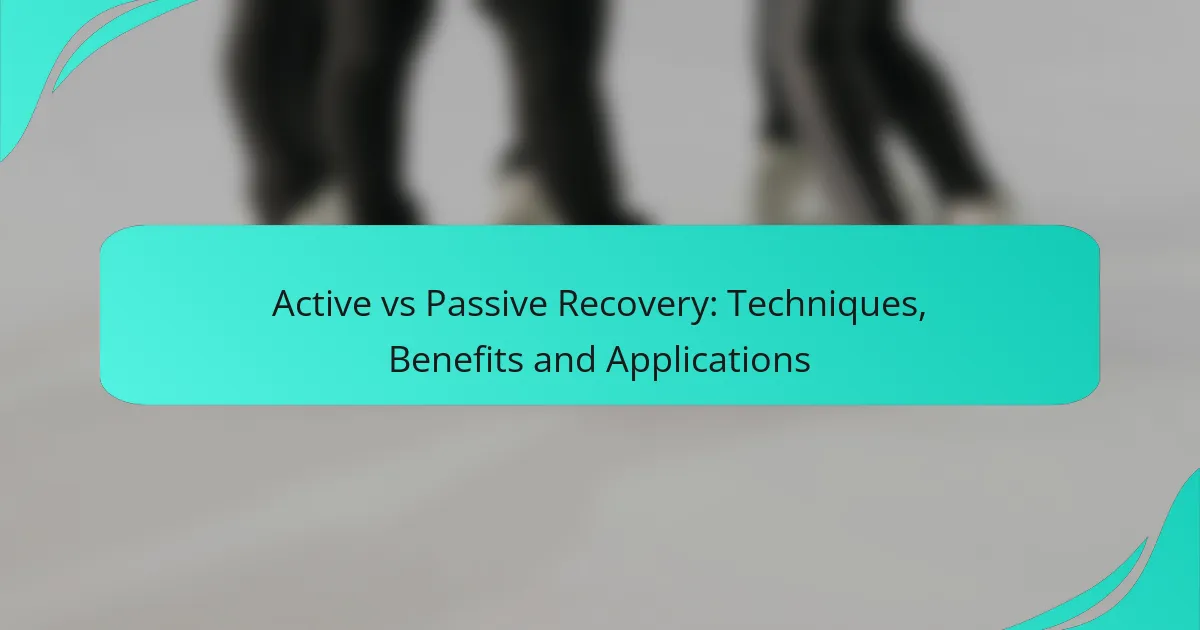Active and passive recovery are two distinct approaches to post-exercise recuperation, each offering unique benefits. Active recovery involves engaging in low-intensity activities that enhance blood circulation and promote muscle repair, while passive recovery allows the body to rest without physical engagement, aiding in overall recuperation. Understanding the techniques and applications of both methods can help individuals optimize their recovery strategies for improved performance and well-being.

What are the benefits of active recovery?
Active recovery involves low-intensity exercise following strenuous activity, and it offers several benefits that enhance recovery. By engaging in light physical activity, individuals can experience improved muscle repair, better circulation, reduced soreness, increased flexibility, and enhanced mental well-being.
Improved muscle repair
Active recovery promotes muscle repair by increasing blood flow to the muscles, which delivers essential nutrients and oxygen. This process helps to clear metabolic waste products that accumulate during intense workouts. Engaging in activities like walking, cycling, or swimming at a low intensity can significantly aid in muscle recovery.
Enhanced circulation
One of the primary benefits of active recovery is enhanced circulation. Light exercise stimulates the cardiovascular system, improving blood flow throughout the body. This increased circulation helps to transport nutrients and oxygen to muscles, facilitating quicker recovery and reducing fatigue.
Reduced muscle soreness
Active recovery can effectively reduce muscle soreness, often referred to as delayed onset muscle soreness (DOMS). By keeping the muscles engaged with gentle movement, the body can alleviate stiffness and discomfort. Activities such as yoga or light jogging can be particularly beneficial in minimizing soreness after intense workouts.
Increased flexibility
Incorporating active recovery into your routine can lead to increased flexibility. Gentle stretching and mobility exercises during recovery periods help maintain and improve the range of motion in joints and muscles. This can be especially useful for athletes looking to enhance performance and prevent injuries.
Boosted mental well-being
Active recovery not only benefits the body but also boosts mental well-being. Engaging in light physical activity can release endorphins, which improve mood and reduce stress. Activities like walking in nature or participating in a low-intensity group class can enhance mental clarity and overall emotional health.

What are the benefits of passive recovery?
Passive recovery offers several advantages, primarily focusing on allowing the body to recuperate without active engagement. This method can enhance overall recovery, reduce fatigue, and promote well-being.
Restoration of energy levels
Passive recovery helps restore energy levels by allowing the body to replenish glycogen stores and repair muscle tissue. Activities such as resting or gentle stretching can facilitate this process, ensuring that energy levels are optimized for future workouts.
Consider incorporating short periods of rest throughout your training schedule, especially after intense sessions. This can be as simple as taking a day off or engaging in light activities like walking.
Reduced risk of injury
By prioritizing passive recovery, athletes can significantly reduce the risk of injury. Resting allows the body to heal and adapt, minimizing the chances of overuse injuries that can occur from continuous training without adequate recovery.
To further decrease injury risk, listen to your body and take breaks when you feel fatigued or sore. Incorporating rest days into your routine can be a proactive approach to maintaining long-term health.
Improved sleep quality
Passive recovery can lead to improved sleep quality, which is essential for overall health and performance. Adequate rest and relaxation help regulate sleep patterns, allowing for deeper and more restorative sleep.
Consider creating a calming bedtime routine that includes activities like reading or meditating to enhance your sleep environment. Aim for 7-9 hours of sleep per night to fully benefit from passive recovery.
Facilitated relaxation
Engaging in passive recovery techniques promotes relaxation, which can alleviate stress and anxiety. Activities such as meditation, deep breathing exercises, or simply resting can help calm the mind and body.
Incorporate relaxation techniques into your daily routine, especially after intense training sessions. This can include spending time in nature, practicing yoga, or enjoying a warm bath to enhance your recovery experience.

How do active recovery techniques work?
Active recovery techniques promote recovery by engaging in low-intensity physical activities that enhance blood circulation and reduce muscle soreness. These methods help facilitate the removal of metabolic waste products while delivering nutrients to the muscles, ultimately speeding up the recovery process.
Low-intensity exercises
Low-intensity exercises, such as walking, cycling, or swimming at a gentle pace, are effective for active recovery. These activities keep the body moving without placing excessive strain on the muscles, allowing for recovery while still engaging in physical activity.
Aim for about 20-30 minutes of low-intensity exercise following a strenuous workout. This duration is sufficient to stimulate blood flow and promote recovery without overexerting the body.
Dynamic stretching
Dynamic stretching involves moving parts of the body through a full range of motion to improve flexibility and reduce muscle stiffness. Unlike static stretching, dynamic stretches are performed in a controlled manner, making them suitable for active recovery.
Incorporate dynamic stretches like leg swings, arm circles, or torso twists for about 10-15 minutes post-exercise. This practice not only aids recovery but also prepares the body for future workouts.
Foam rolling
Foam rolling, or self-myofascial release, helps alleviate muscle tightness and improve blood flow. By applying pressure to specific muscle groups, foam rolling can break down knots and adhesions, enhancing recovery and flexibility.
Spend 1-2 minutes on each major muscle group using a foam roller, focusing on areas that feel particularly tight. This technique can be integrated into your routine several times a week for optimal results.
Yoga and Pilates
Yoga and Pilates are excellent active recovery techniques that emphasize controlled movements, flexibility, and core strength. These practices promote relaxation and can help alleviate muscle tension while enhancing overall body awareness.
Engage in a 30-60 minute session of yoga or Pilates 1-3 times per week to support recovery. Choose classes or routines that focus on gentle movements and stretching to maximize the benefits for recovery.

How do passive recovery techniques work?
Passive recovery techniques involve methods that allow the body to recover without active participation or exertion. These techniques promote relaxation and healing through various means, helping to reduce fatigue and enhance overall recovery.
Rest and sleep
Rest and sleep are fundamental components of passive recovery. Quality sleep allows the body to repair tissues, replenish energy stores, and regulate hormones that are crucial for recovery. Aim for 7-9 hours of sleep per night to maximize these benefits.
Creating a restful environment can enhance sleep quality. Consider factors such as room temperature, noise levels, and light exposure. Establishing a consistent sleep schedule can also improve overall restfulness.
Massage therapy
Massage therapy aids passive recovery by promoting blood circulation and reducing muscle tension. Techniques such as Swedish or deep tissue massage can help alleviate soreness and enhance relaxation. Regular sessions can be beneficial, typically ranging from once a week to once a month, depending on individual needs.
When choosing a massage therapist, look for someone with experience in sports or therapeutic massage. Communicate your recovery goals to ensure the treatment aligns with your needs.
Hydrotherapy
Hydrotherapy utilizes water for therapeutic purposes, such as relaxation and pain relief. Techniques like warm baths, cold compresses, or contrast baths can help soothe sore muscles and improve circulation. This method is particularly effective after intense physical activity.
Consider incorporating hydrotherapy into your routine by taking warm baths with Epsom salts or alternating between hot and cold water showers. These practices can enhance recovery and reduce muscle stiffness.
Compression garments
Compression garments support passive recovery by applying pressure to muscles, which can help reduce swelling and improve blood flow. Wearing these garments during and after exercise can enhance recovery time and decrease muscle soreness.
Choose compression garments that fit snugly but are not overly restrictive. Look for options designed specifically for recovery, such as sleeves or tights, and wear them for several hours post-activity for optimal benefits.
